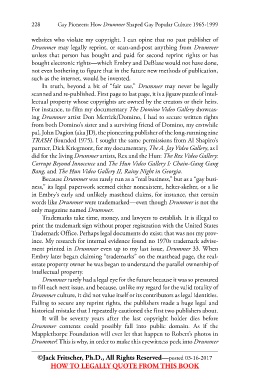Page 246 - Gay Pioneers: How DRUMMER Magazine Shaped Gay Popular Culture 1965-1999
P. 246
228 Gay Pioneers: How Drummer Shaped Gay Popular Culture 1965-1999
websites who violate my copyright. I can opine that no past publisher of
Drummer may legally reprint, or scan-and-post anything from Drummer
unless that person has bought and paid for second reprint rights or has
bought electronic rights—which Embry and DeBlase would not have done,
not even bothering to figure that in the future new methods of publication,
such as the internet, would be invented.
In truth, beyond a bit of “fair use,” Drummer may never be legally
scanned and re-published. First page to last page, it is a jigsaw puzzle of intel-
lectual property whose copyrights are owned by the creators or their heirs.
For instance, to film my documentary The Domino Video Gallery showcas-
ing Drummer artist Don Merrick/Domino, I had to secure written rights
from both Domino’s sister and a surviving friend of Domino, my erstwhile
pal, John Dagion (aka JD), the pioneering publisher of the long-running zine
TRASH (founded 1975). I sought the same permissions from Al Shapiro’s
partner, Dick Kriegmont, for my documentary, The A. Jay Video Gallery, as I
did for the living Drummer artists, Rex and the Hun: The Rex Video Gallery:
Corrupt Beyond Innocence and The Hun Video Gallery I: Chain-Gang Gang
Bang, and The Hun Video Gallery II, Rainy Night in Georgia.
Because Drummer was rarely run as a “real business,” but as a “gay busi-
ness,” its legal paperwork seemed either nonexistent, helter-skelter, or a lie
in Embry’s early and unlikely masthead claims, for instance, that certain
words like Drummer were trademarked—even though Drummer is not the
only magazine named Drummer.
Trademarks take time, money, and lawyers to establish. It is illegal to
print the trademark sign without proper registration with the United States
Trademark Office. Perhaps legal documents do exist; that was not my prov-
ince. My research for internal evidence found no 1970s trademark advise-
ment printed in Drummer even up to my last issue, Drummer 33. When
Embry later began claiming “trademarks” on the masthead page, the real-
estate property owner he was began to understand the parallel ownership of
intellectual property.
Drummer rarely had a legal eye for the future because it was so pressured
to fill each next issue, and because, unlike my regard for the valid totality of
Drummer culture, it did not value itself or its contributors as legal identities.
Failing to secure any reprint rights, the publishers made a huge legal and
historical mistake that I repeatedly cautioned the first two publishers about.
It will be seventy years after the last copyright holder dies before
Drummer contents could possibly fall into public domain. As if the
Mapplethorpe Foundation will ever let that happen to Robert’s photos in
Drummer! This is why, in order to make this eyewitness peek into Drummer
©Jack Fritscher, Ph.D., All Rights Reserved—posted 03-16-2017
HOW TO LEGALLY QUOTE FROM THIS BOOK

